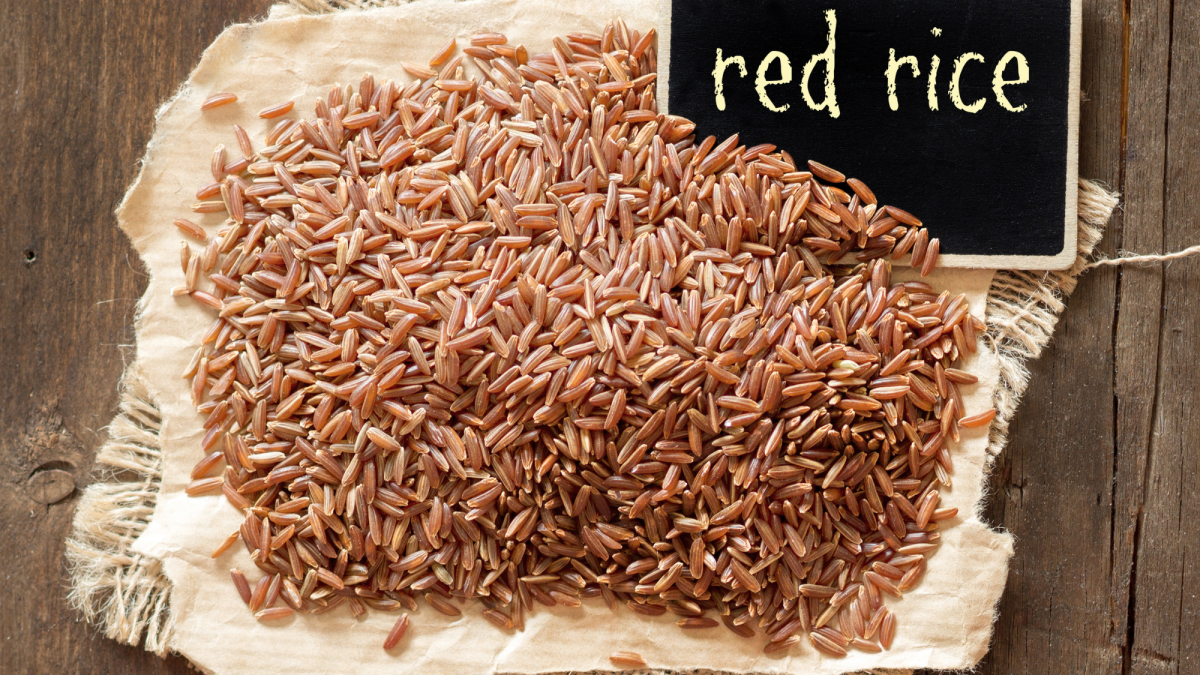Antioxidant Properties of Red Rice

Red Rice Yogurt Drink
November 8, 2022
Red Noodle Rice with Chicken Kafta
December 5, 2022Antioxidant Properties of Red Rice
Guest author : Dr Chong Wei Yan (UCSI University)
Rice is the staple food in developing counties. Malaysians love rice, getting to know which rice is right for you is crucial since it helps to fuel the body, boosts the nutrition and manage body weight in the long term. Rice can be classified into two types, non-pigmented rice and pigmented rice. Pigmented or coloured rice such as red, purple and black rice are abundant in vitamins, minerals and phytochemicals, which are the non-nutritive phytochemicals that have protective or disease-preventing properties.6 The phytochemical compounds are mainly accumulated in the pericarp and bran of the rice kernel. Generally, pigmented rice is unpolished rice with its bran that contributes to high nutrients and phytochemicals than polished white rice.6
Research studies on the nutrients of rice suggested that the nutrition and functional value varies depending upon several factors such as variety, soil quality and agro-climatic conditions in which rice is cultivated, the degree of milling and the preparation methods before consumption.3,6 Polished white rice is more prevalent at household level and widely used for food manufacturing in commercial scale compared to pigmented rice due to its sensory characteristics and low price. However, nowadays, health conscious consumers put their focus in pigmented rice because it tends to provide more nutrients with high antioxidants to the diets. Improving one’s diet by having sufficient amount of natural antioxidant containing foods have been reported to reduce the occurrence of chronic and degenerative diseases6, such as support in the prevention of cancers, improve blood lipid profile, and prevention of diabetic complications or type-2 diabetes.8,10
Phytochemical in pigmented rice
Phytochemicals present in pigmented rice can be divided into following sub-groups, namely carotenoids, phenolics, alkaloids, nitrogen and organo-sulphur containing compounds. While, phenolic compounds are further sub-grouped as phenolic acids, flavonoids, coumarins and tannins. The pigmented rice like red rice shows superior antioxidant capacity and nutritional quality. Anthocyanin and proanthocyanin, a kind of flavonoid are the major pigments responsible for red rice. Besides, the other major phenolic compounds that can be found in red rice include ferulic, vanillic and protocatechuic acid.1 All these phytochemicals have their biological functions to reduce free radicals, oxidative stress and prevent lipid peroxidation.1 Phenolic contents in rice are found to be highly correlated to bran colour, red rice brans demonstrate up to 20 times greater concentrations compared to white or light brown rice bran.4
The antioxidant properties of red rice from different geographical areas have been proven and well recognized by researchers. In Malaysia, the phytochemical and antioxidant properties of two red rice variants (Variant G33 and G37) derived from the cross breeding between Oryza rufipogon and Oryza sativa were studied by comparing among commonly commercialized local white rice (MR219) and Thailand red rice. Variants G33 and G37 produced significantly higher total phenolic content (0.49 and 0.51 mg GAE/g, respectively) than white rice (0.32 mg GAE/g) but lower than Thailand red rice (1.59 mg GAE/g). Vitamin E is another natural antioxidant in grains which prevents oxidative damage of polyunsaturated fatty acids in body cell membranes. The result showed variant G37 (red rice) contained the highest concentration of total vitamin E, followed by the G33 (red rice) and MR219 (light brown rice); whereas Thailand rice (red rice) had the lowest concentration.3 Additionally, in 2018, research from Ghasemzadeh et al. demonstrated that other phenolic compounds like catechin and myricetin were found abundant in red rice.
Antioxidant activities
The antioxidant activities in red rice were consistent with other studies. Research from Thitipramote et al. (2016) suggested that the native Thai red rice had the higher bioactive compounds with higher antioxidant potency than Thai black rice and Japanese brown rice. Red rice had significantly higher total phenolic content (1.018 mg GAE/mg) than black and brown rice (0.755 and 0.069 mg GAE/mg, respectively). Proanthocyanin was found only in red rice (3.168 mg CE/mg). Moreover, the antioxidant activities of radical scavenging activity using Ferric-Reducing Ability Power (FRAP) assay tended to be higher in red rice rather than black and brown rice.
A study from India in 2020 also proved the antioxidant properties of six red rice varieties from Western Himalaya.2 The total phenolic content in the red rice varieties ranged from 79.18 to 691 mg/ 100 g; while the flavonoid content ranged from 45.05 to 48.31 mg/100g.
The antioxidant activity of red rice is largely due to the presence of anthocyanins .1 FRAP assay of Aek Sibundong red rice from Indonesia showed the highest antioxidant activity with an IC50 value of 6.65 µg/mL, closest to ascorbic acid with an IC50 of 5.21 µg/mL when compared to their local black rice and white rice, the smaller IC50 value shows a higher antioxidant activity.
Rice is a fundamental food in many cultural cuisines around the world; more than 90% of production and consumption of rice in the world occur in Asia. Since rice is a vital part of many cultures and a main component of diets, learning how to select a nutritious and right source of rice is essential. With the high antioxidant activity of red rice together with its low GI, high dietary fiber and high minerals, i.e., zinc, calcium, iron and magnesium properties 1, proanthocyanidins present in red rice provide protection against type-2 diabetes, modulate the inflammatory response and protect against some cancers, prevents the risk of heart attacks, helps in reducing bad cholesterol (LDL cholesterol) and provide protection against cardiovascular disease; and anthocyanins present in red rice have properties that can help in weight management.6 In a nutshell, consumers are encouraged to include red rice in daily diet to leverage on the health benefits.
References :
- Agustin, A. T., Safitri, A. and Fatchiyah, F., 2021. Java Red Rice (Oryza sativa L.) Nutritional Value and Anthocyanin Profiles and Its Potential Role as Antioxidant and Anti-Diabetic, Indonesia Journal of Chemistry, 21(4), pp. 968-978.
- Dhaliwal, Y.S., Pandit, A., Verma, A. K., and Gupta, A., 2020. Physical properties and food value of rice varieties of Western Himalaya. Indian Journal of Natural Products and Resources, 11(4), pp. 340-349.
- Fasahat, P., Abdullah, A., Muhammad, K., Karupaiah, T., and Ratnam, W., 2012. Red pericarp advanced breeding lines derived from Oryza rufipogon × Oryza sativa: Physicochemical properties, total antioxidant activity, phenolic compounds and vitamin E content. Advance Journal of Food Science and Technology, 4(3), pp. 155-165.
- Goffman, D. and Bergman, C. J., 2004. Rice kernel phenolic content and its relationship with antiradical efficiency. Journal of the Science of Food and Agriculture, 84(10), pp. 1235-1240.
- Ghasemzadeh, A., Karbalaii, M.T., Jaafar, and Rahmat, A., 2018. Phytochemical constituents, antioxidant activity, and antiproliferative properties of black, red, and brown rice bran. Chemistry Central Journal, 12, pp. 1-13.
- Rathna Priya, T., Eliazer Nelson, A. R. L., Ravichandran, K., Antony, U., 2019. Nutritional and functional properties of coloured rice varieties of South India: a review. Journal Ethnic Foods, 6 (11), pp. 1-11.
- Saleh, A. S. M., Wang, P., Yang, L., Xiao, Z., 2019. Brown Rice Versus White Rice: Nutritional Quality, Potential Health Benefits, Development of Food Products, and Preservation Technologies. Comprehensive Reviews in Food Science and Food Safety, 18(4), pp. 1070-1096.
- Tantipaiboonwonga, P., Pinthaa, K., Chaiwangyena. W., Chewonarinb, T., Pangjitc, K., Chumphukama, O., Kangwand, N., and Suttajita, M., 2017. Anti-hyperglycaemic and anti-hyperlipidaemic effects of black and red rice in streptozotocin-induced diabetic rat. ScienceAsia, 43, pp.281-288.
- Thitipramote, N., Pradmeeteekul, P., Nimkamnerd, J., Chaiwut, P., Pintathong, P., and Thitilerdecha, N., 2016. Bioactive compounds and antioxidant activities of red (Brown Red Jasmine) and black (Kam Leum Pua) native pigmented rice. International Food Research Journal, 23(1), pp. 410-414.
- Walter, M., Marchesan, E., Massoni, P. F. S., Silva, L. P. D., Sartori, G. M. S., Ferreira, R. B., 2013. Antioxidant properties of rice grains with light brown, red and black pericarp colors and the effect of processing. Food Research International, 50 (2), pp. 698-703.





